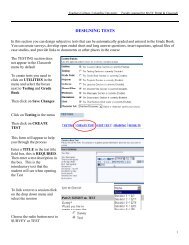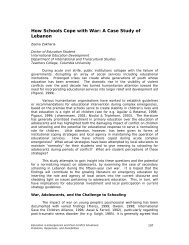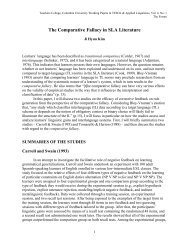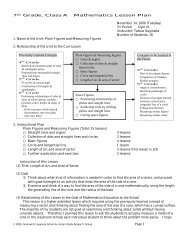UNICEF Mongolia - Teachers College Columbia University
UNICEF Mongolia - Teachers College Columbia University
UNICEF Mongolia - Teachers College Columbia University
You also want an ePaper? Increase the reach of your titles
YUMPU automatically turns print PDFs into web optimized ePapers that Google loves.
CHAPTER 6: TEACHER EFFECTIVENESS<br />
programs” mushroomed, very much to the financial benefit of teacher training instuons. An evaluaon<br />
of these training programs that are largely self-financed is urgently needed. There were also major delays<br />
reported at the school level in the review of the licensing applicaons. It is recommended to streamline<br />
and simplify the applicaon procedure, especially for the young specialists who are supposed to submit<br />
their applicaon package one year aer they graduated from pre-service teacher training.<br />
A second major iniave to enhance teacher effecveness was launched with the comprehensive inservice<br />
teacher training strategy. MECS Ministerial Order #72 from 2008 prescribes a comprehensive<br />
and coherent system of in-service teacher training that includes (a) basic training every five years, (b)<br />
specialized training with credit-bearing as well as non-credit courses, and (c) independent studies. The<br />
basic training has been resurrected from the past and has remained very popular among teachers. It<br />
seems that teachers raise their expectaons of promoon by enrolling in credit-bearing courses that,<br />
more oen than not, are self-financed. The proporon of teachers who have been promoted to lead<br />
teacher or advisor teacher has diminished and has thus generated unease among teachers who have<br />
invested financially in their own professional development. The self-finance regulaons as well as the<br />
close associaon between professional development and promoon (see Table 7) need to be revisited.<br />
The so-called basic training that, within a five-year period, will have reached out to every teacher in the<br />
country is impressive and comprehensive. Unl today, the central level was only able to secure funding<br />
for the fih year teachers. The City Department of Educaon succeeded in enrolling not only fih year<br />
teachers, but also started to reach out to first year teachers. Addional funding is needed to enroll first<br />
year and tenth year teachers across the country.<br />
As menoned in the Preface, <strong>Mongolia</strong> is changing at a rapid pace economically and socially. The situaon<br />
of teachers—their recruitment, their professional development, and their retenon—is closely related<br />
to changes in the society at large. The reforms of the past few years, in parcular from 2007 onwards,<br />
aempted to take into account the need for a greater number of qualified and movated teachers.<br />
The expansion of schooling from 10 to 12 years, internal migraon from rural to urban schools, and<br />
higher educaon explosion were the main drivers for invesng in teacher educaon and improving the<br />
condions of the teacher profession. Over the past five years, economic growth has transformed the<br />
fabric of <strong>Mongolia</strong>n society. The challenges keep changing, but the need to connuously improve the<br />
quality of educaon by effecvely targeng recruitment into teaching, professional development, and<br />
teacher retenon has remained the same.<br />
1<br />
2<br />
3<br />
4<br />
5<br />
6<br />
TEACHERS IN MONGOLIA: AN EMPIRICAL STUDY ON RECRUITMENT INTO TEACHING,<br />
PROFESSIONAL DEVELOPMENT, AND RETENTION OF TEACHERS<br />
95














![TC Tod[...].pdf - Teachers College Columbia University](https://img.yumpu.com/27074883/1/190x252/tc-todpdf-teachers-college-columbia-university.jpg?quality=85)


